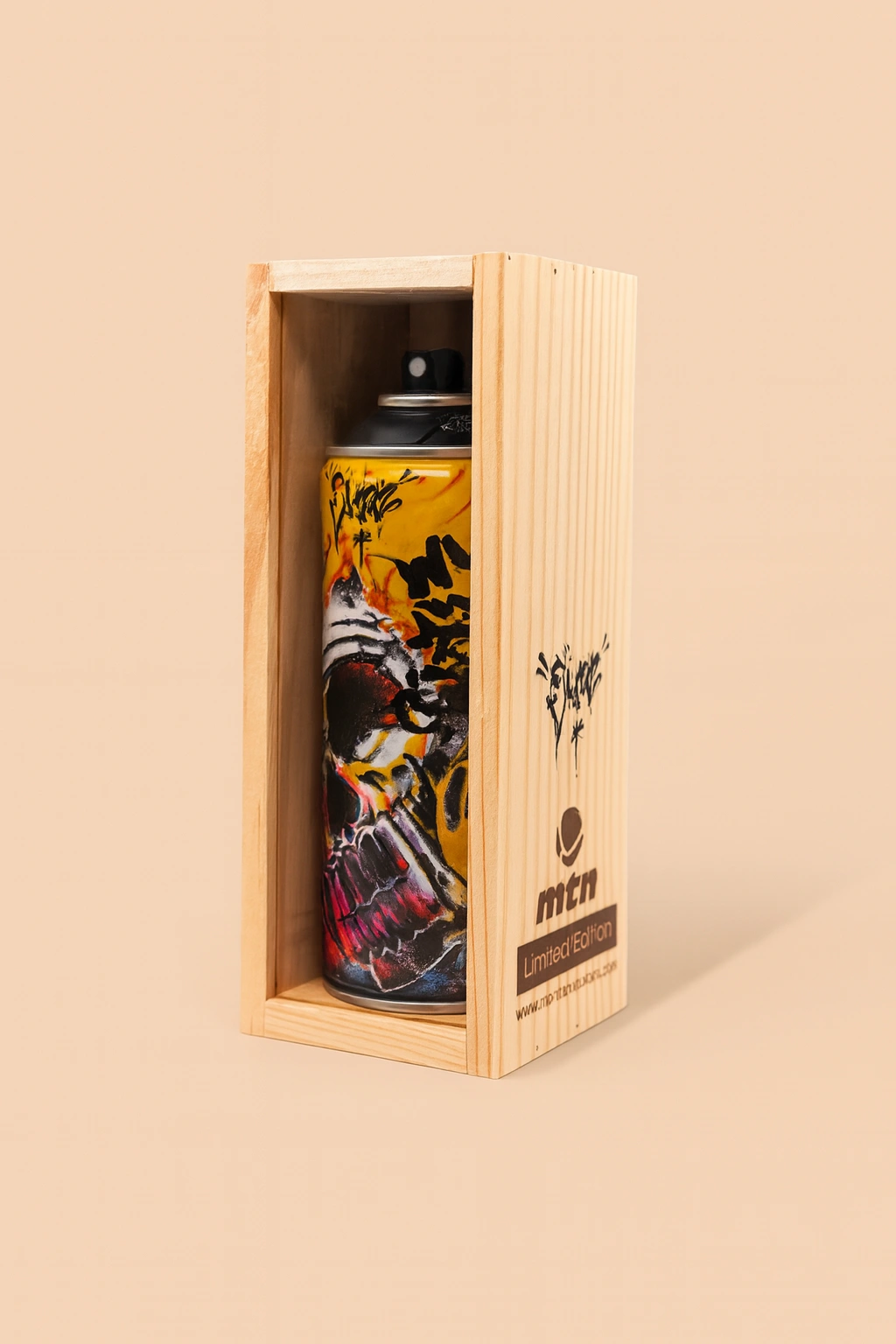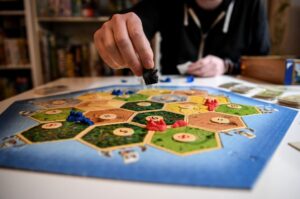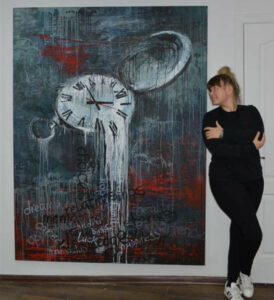In a world overwhelmed by motion, there are moments—frozen, silent, and softly lit—that whisper louder than a crowd. The digital artwork titled “I will tell her that I love her” by the visual storyteller laietano is one such moment. The piece features a child, back turned to the viewer, standing before a weathered turquoise door. A massive satchel weighs on their shoulders, and a bouquet of vivid orange flowers rests gently in their arm. The image, romantic and rustic, asks nothing of the viewer but to pause, look, and feel.
Yet in this pause exists a universe of meaning: a story untold, a confession unstated, and an emotion unguarded. What lies behind that door may be unknown, but what stands before it is love in its purest, trembling form.
Scene Analysis: Anatomy of a Moment
Let us begin with the visual. The background is a flat turquoise wall, sun-faded and peeling, bearing the marks of time and imperfection. It feels Latin American or Mediterranean, perhaps Mexico, Cuba, or southern Italy—places where color and decay coexist in harmony. The door, chipped and scuffed, mirrors this same tension between beauty and wear. It is closed, formidable in its stillness, but not hostile. Rather, it is aged—waiting.
The central figure is a child. Gender-neutral in clothing, their baggy trousers are rolled at the cuff, their brown leather shoes worn but sturdy. A large cloth sack hangs over their shoulder, almost comically oversized, evoking images of 19th-century vagabonds or street sellers. The hat—sun-shaded and broad—obscures their face. Only their stance speaks: feet firm, head slightly bowed, bouquet held forward, as if offering a fragile truth to the universe.
This child could be anyone. That is precisely the point. They become a universal stand-in for the moments when all of us—at some stage in our lives—have stood outside some metaphorical door, gathering courage to speak the words that knot our throats.
A Confession in Bloom: The Flowers as Symbols
The bouquet of orange flowers is not incidental. In the language of flowers, orange blossoms often symbolize enthusiasm, passion, and warmth. They evoke the budding of something new—perhaps not yet love, but the aching possibility of it. Unlike the crimson rose, which declares love boldly, orange blooms hint at the precipice: that flickering edge between friendship and something deeper.
There’s a poetic contradiction in the child’s gesture. Flowers, symbols of beauty and light, are offered from hands roughened by travel, hardship, or both. This juxtaposition adds weight to the gesture. These are not store-bought roses. They are foraged truths, clutched awkwardly, and held out with all the vulnerability the child can muster.
Echoes in Literature: The Door, the Child, the Journey
The image instantly recalls motifs that run deep through literature. The door is a classic literary boundary—between past and future, ignorance and knowledge, fear and fulfillment. In The Secret Garden by Frances Hodgson Burnett, the door hides a lost, neglected world until a child’s curiosity and courage brings it to life again. Similarly, in Pan’s Labyrinth, the portal between worlds becomes a threshold of self-discovery and sacrifice.
The child in laietano’s image also evokes archetypes found in literary classics. Think of Pip in Great Expectations, offering kindness despite poverty, or the little match girl in Hans Christian Andersen’s tale, carrying warmth in a cold world. There’s also a whisper of Antoine de Saint-Exupéry’s The Little Prince, whose quiet existential wanderings ask us to re-examine the essence of connection and love.
The journey implied in this image—the oversized bag, the tired posture, the solitary stance—echoes the bildungsroman tradition: the coming-of-age story. But here, the growth doesn’t come from outward adventure; it comes from the internal reckoning that leads to a simple, brave decision: to express love.
Romanticism and Realism: Where Art Transcends Genre
There’s a Romantic pulse in this work, not only in theme but in tone. Romanticism, in the tradition of Blake, Wordsworth, and Caspar David Friedrich, values emotion over reason, nature over machine, and individual experience over collective logic. The painting does not ask what will happen when the child knocks. It reveres the moment before—the swell of feeling, the tremor of intention.
At the same time, there is a Realist undertone. The child’s clothes are dusty. The wall is chipped. This is not idealized love—it is love from the margins, love despite exhaustion, love that arrives ragged but intact. The mix of Romantic hope and Realist grit creates a tension that makes the image linger in the viewer’s psyche long after first glance.
Time and Silence: Narrative Through Absence
One of the most striking features of this piece is what it does not show. We do not see the child’s face. We do not see the door open. We do not hear the words spoken or unspoken. This narrative through absence invites the viewer to complete the story.
What has brought the child here? A first crush? A mother long estranged? A friend now gone? The narrative could be romantic, familial, platonic, or elegiac. The image does not specify—and in doing so, it honors the complexity of human emotion. Love, after all, wears many masks, and confession takes many forms.
In silence, the piece speaks volumes. It mirrors the emotional architecture of moments in real life where everything hangs in the balance—where time seems to pause, heartbeats thrum loudly, and the entire world shrinks to a door, a breath, a choice.
Sociocultural Readings: Migration, Memory, and Margins
Beyond the emotional and literary, one can read the image through a sociocultural lens. The oversized bag hints at displacement. The image could easily represent a migrant child, traveling across borders—literal or metaphorical—carrying not just belongings but histories. In this interpretation, the door becomes not only a threshold of emotion but of belonging.
The urban setting, while charming, is worn. Cracks in the paint, faded signage, and a sense of aged permanence imply economic hardship or postcolonial stasis. The child, then, is not just declaring love; they are asserting humanity in a world that often overlooks the vulnerable.
This reading dovetails with global themes of child labor, diaspora, and perseverance. It adds weight to the image’s tenderness. When love is voiced by those who have the least, it resounds the most.
Artistic Technique: Texture, Tone, and Light
Laietano’s technique deserves mention. The image, though digitally rendered or heavily post-processed, emulates oil painting through use of texture and saturation. The turquoise wall is not flat—it carries the grainy depth of plaster. The lighting is bright but softened, as though bathed in late afternoon sun, casting diffuse shadows and warming the entire composition.
Color is critical here. The dominant turquoise creates calm, but also melancholy. The orange flowers disrupt this cool palette with warmth—like emotion breaking into order. The brown and tan of the child’s clothing suggests earth, grounding the piece in reality despite its painterly aesthetic.
The composition is balanced, almost mathematically centered, but it is the asymmetry of human emotion—the tension in the child’s posture, the slight lean forward—that provides emotional motion in an otherwise static frame.
The Universal Moment: Why This Image Matters
In its stillness, I will tell her that I love her becomes a universal tableau of courage. Who among us hasn’t stood at the threshold of vulnerability? Who hasn’t carried emotional weight long distances, only to tremble at the moment of disclosure?
This artwork does not shout. It does not declare war, scandal, or spectacle. Instead, it honors the whisper of the heart before it breaks or blooms. In today’s climate of rapid reactions, constant noise, and performative emotion, this quiet image becomes a radical act.
It reminds us that the most courageous thing one can do is tell another, “I love you.”
Conclusion: A Door Left Open
Ultimately, laietano’s artwork is not a finished story—it is a door left ajar. It invites each viewer to bring their own memory, their own trembling moment, and lay it beside the child’s.
Perhaps you once stood before a literal door, clutching flowers or letters or nothing but your breath. Perhaps you didn’t knock. Or perhaps you did, and everything changed.
The artwork does not answer these questions. It doesn’t need to.
In a single, delicate frame, it reminds us: love is not a grand gesture. It is a quiet arrival, a soft offering, a whispered truth in a noisy world.
No comments yet.








